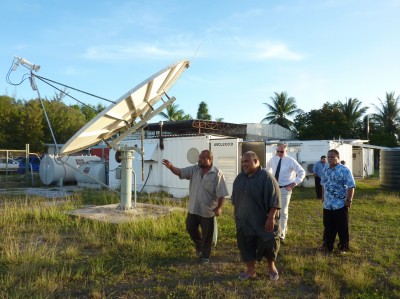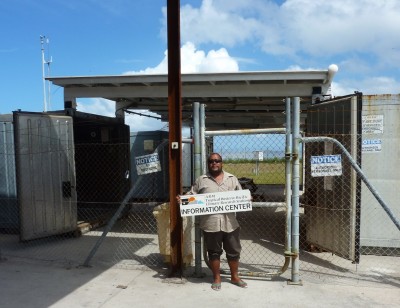
After 15 years, the U.S. Department of Energy’s ARM observation site at Nauru Island is in the history books, with just a small but significant plaque left behind to mark its chapter in obtaining climate data at the smallest republic in the world. The plaque states:
“On this site from 1998 until 2013, the Nauru ARM operations team worked with professionalism and dedication to provide the U.S. Department of Energy with unprecedented data about atmospheric processes from a critical region in the global climate system. With this memento, we share our sincere gratitude and thank the many Nauru team members for their contributions to the site and its role in climate research.”
On September 23, three government ministers from the Republic of Nauru joined a nostalgic walk through the vacated ARM site prior to an evening reception honoring the many people who were instrumental in operating the site through the years. Kim Nitschke, from Los Alamos National Laboratory, led the closeout activities in his role as oversight manager for ARM Facilities in the Tropical Western Pacific, including Nauru. At the reception, he presented plaques and heartfelt thanks in recognition of all the partnerships, teamwork, data, and memories collected through the years at the tiny island in the Pacific.
“A lot of yarns were told from the beginning stages through to the more ‘interesting’ challenges. A good way to wrap up 15 years of dedicated service,” said Nitschke. ”
In 1998, ARM leadership ventured to establish an atmospheric measurement site in Nauru despite the challenges—and healthy skepticism—of continuous operations in such a remote location with limited infrastructure. Now, thanks to data collected from the site through the cooperation of the Nauruan people, scientists have answered questions about a variety of tropical phenomena, including the El Niño Southern Oscillation, storm clouds and rainfall, and the so-called “island effect.”
“We now understand quite a bit about El Niño/La Niña, but not so much about the Madden Julian Oscillation,” said Chuck Long, a researcher at Pacific Northwest National Laboratory and the science leader for ARM’s Tropical Western Pacific sites. “The MJO signal is quite apparent in data from the ARM site at Manus, but does not appear in the Nauru data. So while it would be great to keep both sites up, it’s completely understandable to now consolidate resources at Manus.”

Long could not attend the reception in person, but asked Nitschke to pass along his sincere thanks to all. Posted in the ARM Field Notes Blog, he emphasized their importance to the site and its contributions to atmospheric science.
Site operations and data collection officially ended on August 30, with all “return to USA” items packed and ready for uplift. At the closing reception, the Acting President, Minister Cook, graciously accepted the transfer of remaining ARM infrastructure and equipment; the official handover to the Nauru Department of Commerce, Industry and Environment occurred the following day.
More photos of the site and closing activities are available in Flickr.

